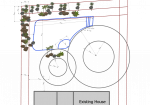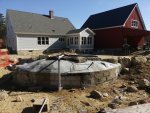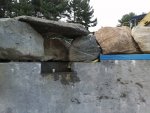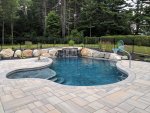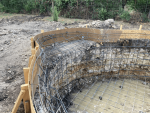Hello, Everybody.
We are planning to build a pool and apparently are not alone, as the demand is up there with hand sanitizer and TP. After meeting with many PBs, very few got back to us with a quote or seemed knowledgeable about permitting, electrical clearances, protected tree critical root zones and narrow access excavation. The few estimates we did receive were over $80K for a simple pool and spa build. After lining up some subs on my own to find the answers for excavation, gas plumbing, and communicating with the permitting and electric company, I realize going owner builder will be the way to go. I enjoy this stuff anyway.
The image is my rough site plan for how big the pool can be, though, we may downsize it some. Not sure yet.
Can anyone recommend a consultant company that is familiar building pools in Austin, TX? There are a few, however, i'd like to know if they have good recommendations Austin, or just try to have some basic guidance for all cities. I can draft the permitting docs and application, and other drawing and mapping material, and run the electrical myself, but think hiring out most of the work would be best.
If you can recommend subs, mainly a plumber and shotcrete contractor, I should be able to estimate the costs and get going soon. If anyone is willing to recommend any and all subs in the Austin area, i'd be extremely grateful.
Any and all guidance is appreciated, and thank you to everyone who has contributed to this forum, it's really great.
We are planning to build a pool and apparently are not alone, as the demand is up there with hand sanitizer and TP. After meeting with many PBs, very few got back to us with a quote or seemed knowledgeable about permitting, electrical clearances, protected tree critical root zones and narrow access excavation. The few estimates we did receive were over $80K for a simple pool and spa build. After lining up some subs on my own to find the answers for excavation, gas plumbing, and communicating with the permitting and electric company, I realize going owner builder will be the way to go. I enjoy this stuff anyway.
The image is my rough site plan for how big the pool can be, though, we may downsize it some. Not sure yet.
Can anyone recommend a consultant company that is familiar building pools in Austin, TX? There are a few, however, i'd like to know if they have good recommendations Austin, or just try to have some basic guidance for all cities. I can draft the permitting docs and application, and other drawing and mapping material, and run the electrical myself, but think hiring out most of the work would be best.
If you can recommend subs, mainly a plumber and shotcrete contractor, I should be able to estimate the costs and get going soon. If anyone is willing to recommend any and all subs in the Austin area, i'd be extremely grateful.
Any and all guidance is appreciated, and thank you to everyone who has contributed to this forum, it's really great.


